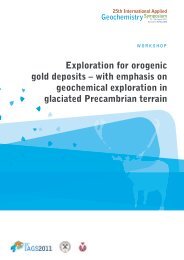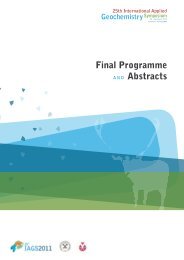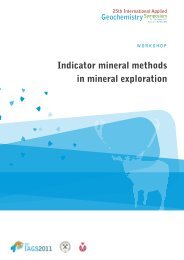IOCG and Porphyry-Cu deposits in Northern Finland ... - IAGS 2011
IOCG and Porphyry-Cu deposits in Northern Finland ... - IAGS 2011
IOCG and Porphyry-Cu deposits in Northern Finland ... - IAGS 2011
You also want an ePaper? Increase the reach of your titles
YUMPU automatically turns print PDFs into web optimized ePapers that Google loves.
Hannuka<strong>in</strong>en deposit<br />
The Hannuka<strong>in</strong>en deposit is the largest known deposit<br />
<strong>in</strong> the Kolari area with current resource estimate<br />
about 200 Mt (Table 1). The deposit consists<br />
of five gently west dipp<strong>in</strong>g lenticular semi-massive<br />
magnetite lenses hosted by Ca-cl<strong>in</strong>opyroxene <strong>and</strong><br />
act<strong>in</strong>olite skarns (Fig. 3). The magnetite lenses <strong>and</strong><br />
the skarns overpr<strong>in</strong>t variably albitized Hapar<strong>and</strong>a<br />
Suite diorite <strong>and</strong> Savukoski Group tholeiitic volcanic<br />
rock (Figs. 2-3). The deposit is structurally controlled<br />
by one of the thrust zones of the Pajala-Kolari<br />
shear zone system.<br />
The <strong>Cu</strong>-Au m<strong>in</strong>eralization is dom<strong>in</strong>antly<br />
hosted by the magnetite-rich lenses, <strong>and</strong> partially<br />
by the skarns. Although <strong>Cu</strong> <strong>and</strong> Au occur <strong>in</strong> anomalous<br />
concentrations throughout the deposit, only part<br />
of the deposit is <strong>Cu</strong>-Au m<strong>in</strong>eralized. The richest<br />
<strong>Cu</strong>-Au grades are with<strong>in</strong> the Laur<strong>in</strong>oja ore body <strong>in</strong><br />
which the best reported <strong>in</strong>tercepts are ca. 0.8% <strong>Cu</strong><br />
<strong>and</strong> 0.3 g/t Au along 35 meter of core (Northl<strong>and</strong><br />
data). However, as all the reported resource estimates<br />
are based on iron cut off, the exact size <strong>and</strong><br />
grade of the <strong>Cu</strong>-Au-richest part is unknown.<br />
The ore m<strong>in</strong>erals at Hannuka<strong>in</strong>en are magnetite,<br />
pyrite, pyrrhotite <strong>and</strong> chalcopyrite bornite,<br />
tellurides, gold, molybdenite, <strong>and</strong> uran<strong>in</strong>ite (Hiltunen,<br />
1982; Niiranen et al., 2007). Native gold occurs<br />
<strong>in</strong> silicate gangue <strong>and</strong> <strong>in</strong>clusions <strong>in</strong> sulfides <strong>and</strong><br />
magnetite (Hiltunen, 1982;<br />
Fig. 3. Surface<br />
geology <strong>and</strong> a<br />
cross section of<br />
the Hannuka<strong>in</strong>en<br />
ore field. The deep<br />
Kivivuopio ore<br />
body is omitted<br />
from the surface<br />
geology. After<br />
Hiltunen (1982),<br />
redrawn by P.<br />
Kurki.<br />
21






